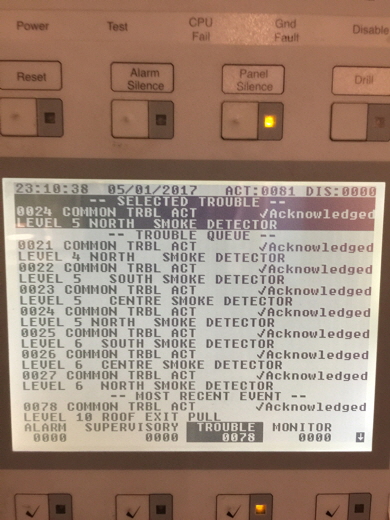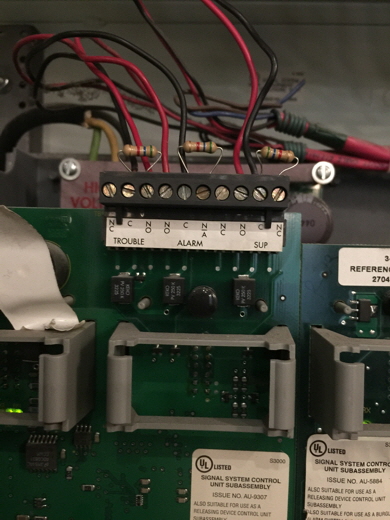Tech-News & Views
|
|
||||||||||||||||||||||||||||||||||||||
SUBSTANDARD TESTING SPARKS MAJOR INVESTIGATION!What started out as a fairly simple Section 6 Verification on a tenant improvement in a Lower Mainland speciality store, which involved the installation of an addressable photo-electric smoke detector and three speakers, has prompted a major investigation into the practices of three prominent local service providers (two of whom are named on a ULC Shared Station Certificate for fire signalling services). These images (taken during the Verification) feature two of the issues that were identified (these same pictures also appear in our latest EDITORIAL to highlight several other disturbing aspects frequently confronting technicians performing testing, inspection and Verification services in Canada).
|
|
||||||||||||||||||||||||||||||||||||||
|
Here are the deficiencies from the CAN/ULC-S537-13 Appendix “C” that’s been submitted: “The system’s stand-by batteries have insufficient capacity to provide the required stand-by and alarm operation as required in the Standard for Installation of Fire Alarm Systems (CAN/ULC-S524-01) in effect at the building was constructed. In the absence of any documentation that would support the generator being a part of the fire alarm system’s emergency power supply (which the original Verification may have identified and documented), then the system’s stand-by battery must be replaced with a set that is appropriately sized. Further testing on the batteries was curtailed pending their replacement. Interconnection wiring between the two batteries serving as the emergency power supply must be replaced with a single cable/connector assembly as required in the manufacturer’s printed installation instructions. There is currently a pair of 18AWG wires being used crimped to single connector ends. Data Communication Link isolators are not provided between <the building’s common control and the retail space>. A short fault was imposed at the north manual station location in <the retail space>, which resulted in the complete shutdown of the loop controller. Seventy-eight (78) active and supporting field devices reported communications failures and did not restore while the short was active. Restoring communications required removal of the short and a system wide restart. Additional investigation is merited to ensure the correct functionality of the isolators we identified were part of the system but did not perform as required. Enabling “All Call Paging” function results in a short fault on the main paging amplifier. “All Call Paging” does not operate. Paging to selected zones (including selective activation of all paging zones) does not appear to inhibit paging functions. Two (2) paging circuits (for specific stair wells) do not activate on either an “All Call” or by selective paging. There is no documentation available on site that provides a “Sequence of Operation” which we could review to explain this anomaly. We have noted it as a deficiency requiring additional troubleshooting/investigation.” The issue with the communicator was mentioned in the Remarks section of the Report for reasons that are self-explanatory: “In addition to the deficiencies we’ve listed in this report, we had also identified several issues with the premises equipment providing the fire signal transmission means. We noted that the communicator had several troubles displayed when we were documenting signals to the monitoring station as part of the speaker, battery, and data loop testing we performed. These included a Zone 1 and Zone 3 supervisory fault caused by the incorrect termination of the fire alarm system’s “alarm” and “supervisory” relays. This was corrected. In addition to these trouble indications, a “system fault” and “communication trouble” was also displayed. Further investigation by a technician from <the security provider> revealed a disconnected cable inside their communicator equipment. This has all been corrected. We have been unable to review <the security provider’s> Appendix “C” report and have expressed some concern with not being able to identify the circuit disconnect means for the communicator. It appears to be sharing power with other building security related equipment. If this is, in fact, the case, then the Shared Station Certificate could be compromised. Further investigation is merited.” A complaint has also been filed with ASTTBC against the three RFPT AL endorsed technicians who, collectively performed and signed off on the annual inspection of the system in December 2016. In reviewing the only documentation made available, several rather glaring omissions in the test report (based on the correct version of the Standard, for a change) were uncovered. The failure to document the proper testing of the Data Communication Link was the one that really stood out. “NA” in the test record highlighted an altogether chillingly familiar practice, which may actually point to an even larger problem; the lack of training on the equipment being tested. We were appalled that not one supporting field device was identified in the report, no smoke detector sensitivity scores were recorded, and the emergency power supply testing included some purely fictitious results that failed to mention there was an emergency generator in the building. And the list goes on. Bogus CAN-ULC-S536-04 Annual Test Redacted by Frank Kurz on Scribd
We’ll be UPDATING this story as the investigation continues. |
|||||||||||||||||||||||||||||||||||||||
|
|
|
||||||||||||||||||||||||||||||||||||||
The Fire Technicians Network
+1 (888) 340-3473
“We are not a professional union, but together, we are a union of professionals!”
What we’re all about!
We are not affiliated with ASTTBC, CFAA, CANASA, NFPA, NAFED, or NICET (although we encourage you to explore and objectively evaluate the benefits associated with supporting their individual efforts). Membership in the Fire Technicians Network is entirely voluntary. Are you up to the challenge of demonstrating your commitment to public safety and the highest standard of professional practice?
Copyright © 2007 - 2020 The Fire Technicians Network. All Rights Reserved

